PARA-PARASOPHIA: On the sidelines at the Kyoto International Festival of Contemporary Culture
by Asada Akira
para- : alongside, auxiliary, pseudo-
PARASOPHIA: Kyoto International Festival of Contemporary Culture 2015 is now on. Although I confess to having no great expectations of the event, to be honest I never imagined it would be quite such a letdown. With international arts events of this ilk now popping up all over the place, and a subsequent, unsurprisingly decline in average standard, I admit to not following such festivals very closely since the 1990s, so any objective appraisal is best left to professional art critics and art journalists. However I’d have to say that personally, among international arts festivals, PARASOPHIA would rank as one of the more disappointing.
An international arts fest in Kyoto?
I tend to think of myself as an inherently run-of-the-mill, reasonably commonsense sort of individual who believes there is no point creating even more international arts festivals than we have now; or if people insist on doing so, it only makes sense if they can come up with some truly innovative format. If pushed however, I would say that if you are going to hold a festival of this sort in Japan, Kyoto is the obvious choice. Take the Venice Biennale, for example: that it has steadfastly remained in the spotlight is mainly down to its location, to wit, Venice. Because even if the Biennale itself turns out to be somewhat of an anticlimax, Venice is still a city people are happy to visit time after time. From an overseas perspective particularly, Kyoto is the only equivalent Japanese location. Certainly if I were a cultural official, hoping to curry favor with a nationalist government keen to position Japan globally as that “beautiful country” to which Mr. Abe aspires, I would definitely lavish funding and personnel on establishing an international arts festival in Kyoto. But today, when the best we can manage in this country is a half-hearted attempt at being “Cool Japan,” for better or worse there doesn’t seem to be anyone with the requisite ambition.
So the idea of Kyoto running its own international arts festival was raised. The stumbling block: not enough cash. Word went round quite some time ago that a certain “international curator” had declined the post of director, citing a lack of funding. Of course, if the money is not there, it simply isn’t, and it should have been possible then to come up with radical formats and methods to make the event work. Although to run a festival on a par with the Venice Biennale would have required if not ten times, then at least several times the allotted budget, a more radical approach would have delivered a festival ten times more interesting on a tenth of the budget. What eventually materialized however – PARASOPHIA – represents the very worst-case scenario: neither one nor the other but instead a timid, sorry excuse for an arts festival.
It possesses neither the clearly defined concepts of Sapporo International Art Festival 2014 organized by Sakamoto Ryuichi and Yokohama Triennale 2014 by Morimura Yasumasa, nor the ample opportunities for local discovery of festivals such as the Echigo-Tsumari Art Triennale and Art Setouchi. Nor indeed does it make up for these by cleverly presenting a sample of trends in the global art world. Thus, the main problem with PARASOPHIA in my view is the dearth, for the audience, of any discoveries worthy of the name. Sure, if we’re talking big names PARASOPHIA offers the likes of William Kentridge and Pipilotti Rist, but these are stars of the 1990s international arts festival circuit, who on this occasion do not bring anything especially novel to the table. Cai Guo-Qiang’s Kyoto Da Vincis is guaranteed to be an epic effort that will lure the punters, and fun to boot- – yes not only the giant tower, but even just looking at the Jackson Pollock and Yves Klein robots – but ultimately the work is an extension of the Peasant Da Vincis and Children Da Vincis rolled out on an ongoing basis around the world by an artist who could be described as a one-man international arts festival, and thus not exclusive to Kyoto. Likewise, witnessing the “big reveal” – pole dancing and all – of Yanagi Miwa’s stage trailer in front of Nijo-jo was undoubtedly thrilling (for the duration of PARASOPHIA it will be parked in front of the Kyoto Municipal Museum of Art, with various events scheduled, including a version of Nichirin no tsubasa (The Wing of the Sun) by rapper Ito Seiko), but again, this showing of the trailer is merely a link between the work’s debut at Yokohama Triennale 2014 and the performance of Nichirin no tsubasa to mark the 70th anniversary of the birth of Nakagami Kenji in 2016. So was I pleasantly surprised to discover any artists or works I’d never heard of? The answer is no. Though I was personally glad to have seen work by important socially-engaged artists like Allan Sekula, who died in 2013, and Harun Farocki, who passed away last year, surely one should come away from a contemporary arts festival with more than such musings?
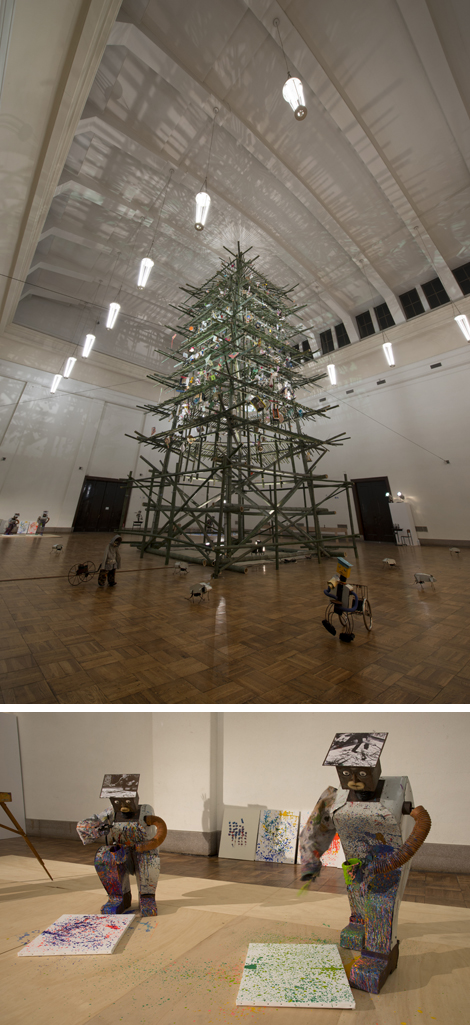
Cai Guo-Qiang, Kyoto Da Vincis, 2015
Installation view, PARASOPHIA: Kyoto International Festival of Contemporary Culture 2015
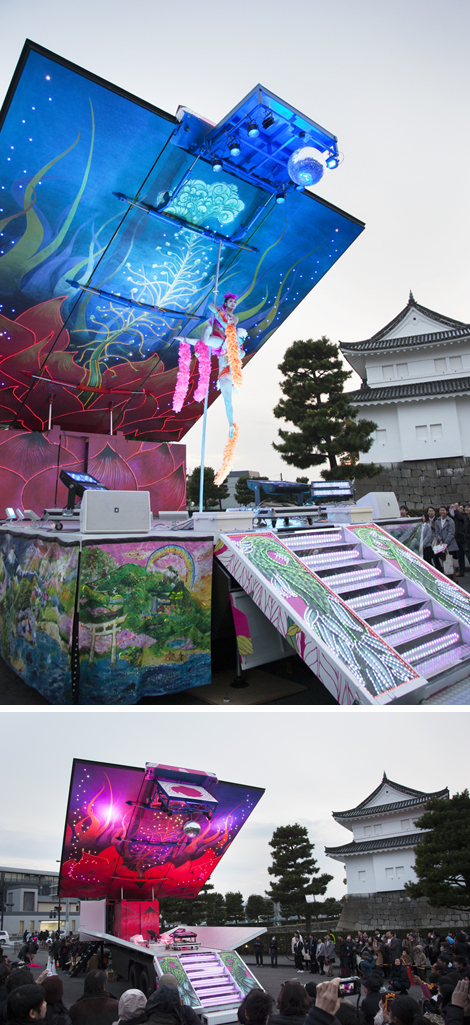
Yanagi Miwa, Stage trailer for Nichirin no tsubasa, 2014
PARASOPHIA: Kyoto International Festival of Contemporary Culture 2015
So while the exhibits at the Kyoto Municipal Museum of Art in particular can, I suppose, be recommended to visitors who are attempting to contemplate contemporary art seriously, but have not to date had much opportunity to look at any contemporary art, frankly, they cannot to anyone who follows contemporary art to any degree, or would be curious to go along if something looked interesting. However, if I may digress slightly, this is an excellent opportunity to take a fresh look at the Kyoto Municipal Museum of Art itself. Usually it has several exhibitions running concurrently, so a show occupying the entire building is exceedingly rare. Thus seen through new eyes, it becomes obvious that this building in classic Imperial Crown style really is of a scale befitting an imperial art museum. While the stairway hall through the entrance does regrettably give the place a cramped feel, behind it is a vast atrium (where Cai Guo-Qiang’s Kyoto Da Vincis is installed), from there leading straight out the back of the building (through the PARA CAFE). There are actually plans afoot to build a contemporary art extension on the Museum, but as Nawa Kohei & SANDWICH, designers for the PARA CAFE have correctly pointed out, ample display space could be created by renovating the existing building, so there is no need to build a new one (one proposal apparently is to add the new extension on the front, to showcase it, but it would be far better to leave a space where the facade of the existing building can be viewed in its entirety). Taking such developments into consideration also, this is a valuable opportunity to reassess the Museum as a whole. In particular, be sure to go down to the basement level that used to house the cloakroom etc., where on the one hand you’ll find Takamine Tadasu’s work on show, and on the other an unmissable display on the “birth of the art museum.” Stepping outside, from somewhere you will catch the strains of a woman singing The Internationale. Imperial Crown architecture and The Internationale: a simple yet effective intervention by Susan Philipsz. There is another sound installation by Philipsz, by the way, consisting of a blend of three songs, on the Kamogawa delta near the Kamo Ohashi Bridge. It’s a spot familiar to everyone who lives in Kyoto, and the river can also be crossed on stepping stones, so worth a look for tourists as well. I have to say though that of Philipsz’ lyrical works, The Cuckoo’s Nest ringing out across the Sapporo Art Park Sculpture Garden at the Sapporo International Art Festival 2014 was more impressive.
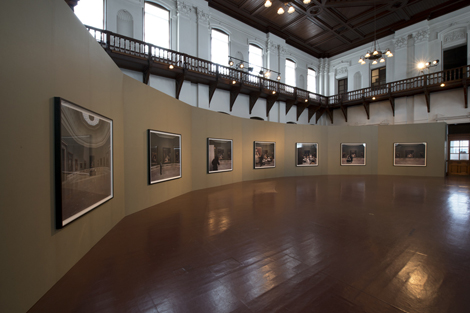
Morimura Yasumasa, Museo del Prado seriese, 2013
Installation view, PARASOPHIA: Kyoto International Festival of Contemporary Culture 2015
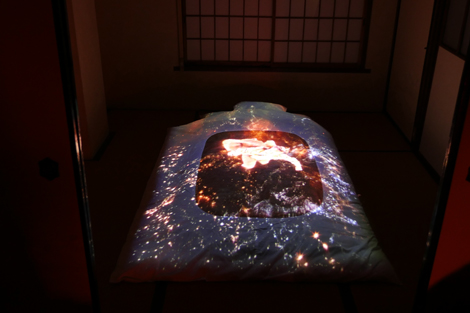
Still from Pipilotti Rist, Evolutionary Training (Horikawa Worry Will Vanish)
Installation view, PARASOPHIA: Kyoto International Festival of Contemporary Culture 2015
Courtesy of the artist, Hauser & Wirth, and Luhring Augustine
Suujin district
There are works scattered from the Kamogawa delta to the Museum of Kyoto, Kyoto Art Center, Horikawa Danchi and so on, and it is tricky to know which are worth visiting. For example, the Las Meninas series on display in the Museum of Kyoto is a milestone in the practice of Morimura Yasumasa, but the exhibition at the Shiseido Gallery the year before last had more finesse, and the audio commentary added subsequently is annoying. And even if watching Pipilotti Rist’s latest in a room at the Danchi is not a bad idea, while viewing it sprawled on a futon might be alright, standing looking down on a video projected on a futon is not especially comfortable. What is definitely worth taking the opportunity to visit though, is the Suujin district.
Kyoto is an old town, and there are remnants of former buraku (discriminated communities) all over the place. In particular, the Rokujo-Gawara (riverbed) on the Kamogawa was once an execution site, and the nearby Suujin district (east of Kyoto Station, before the Kamogawa) the largest buraku community (or dowa chiku – “assimilation district”) in Kyoto. It was also the only buraku settlement to establish its own bank (1899), and is believed to have been indirectly linked to the founding in Kyoto in 1922 of the Suiheisha (Levelers Association), the main buraku liberation organization. There you will find the Bank of Yanagihara Memorial Museum so take a look inside, then go for a stroll in the vicinity. You will see a complex maze of empty lots, but be surprised to find them all fenced off, “unauthorized occupation” not permitted. Within you will spy “Suujin Park,” site of a Hoefner/Sachs installation. The installation consists of a jungle gym sort of framework with various objects suspended from it. An old hand-operated pump that squirts water high in the air. A sundial-like object consisting of a stainless steel column protruding from a stone ring. These are all positioned on separate fenced-off vacant lots. Is the bicycle placed in the nearby Takasegawa River in lieu of a waterwheel part of the work as well? (It might have been interesting to attract the “Art-Power Plant” here.) Dotted around the vacant lot beside “Suujin Park” are objects resembling garden rocks made from black metal mesh, and the fact that the lot itself is surrounded by a fence makes these even more striking.
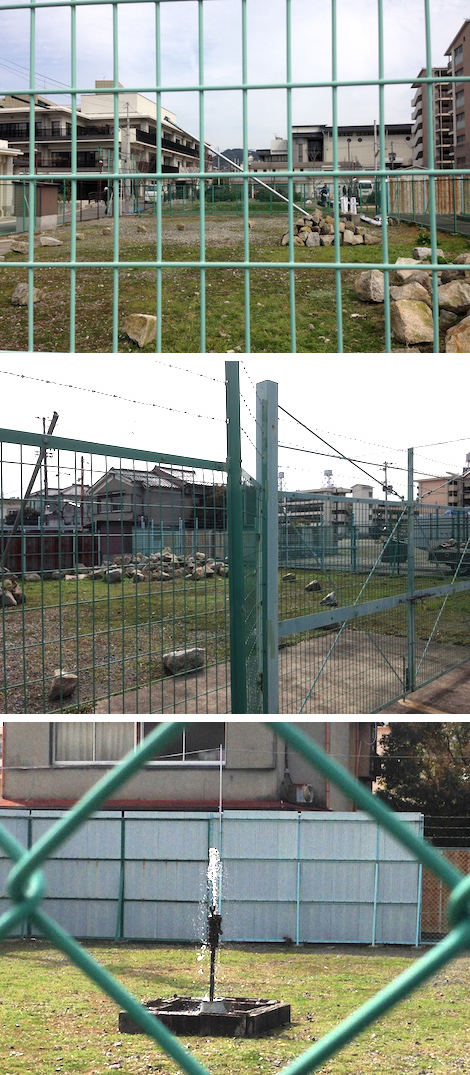
Hoefner/Sachs, Suujin Park, 2015
Installation view, PARASOPHIA: Kyoto International Festival of Contemporary Culture 2015
In actual fact, the last work I mentioned here is not part of PARASOPHIA itself, but a piece by Sugiyama Masayuki, for the still moving exhibition organized by the Kyoto City University of Arts and staged as a PARA-PARASOPHIA event, so to speak, at the former Suujin Elementary School (closed in 2009) and in the surrounding area. The Kyoto City University of Arts is actually to move to the Suujin area, in a move to encourage the district’s gentrification. As part of this process, related artists are launching unconventional artistic interventions from their own individual standpoints. It was prior to the show’s opening when I visited the former elementary school, so I must go take another look, but even at the preparatory stage, this had the obvious makings of an intriguing event. One of the main organizers, Ishihara Tomoaki, let slip his concern that the event had drifted a little too far into the realm of banal nostalgia, but even just recording and transferring the disappearing vestiges of a place so rich in historical memory must have a significance beyond that of any facile sentimentality about the past. Take for example the Hisakado Tsuyoshi installation in the class 1, second grade classroom. The blackboard in front has nothing written on it, but the sound of writing on a board plays from a speaker, a bare light bulb flickering on and off in response. The back wall is crammed with round mirror clocks of various sizes. And occasionally, a powerful white noise drowns out the scratching on the blackboard. After seeing that work, while watching eight pupils playing ball on the old school grounds, my mind turned to many things – far more cogitation than was prompted by the whole of PARASOPHIA.
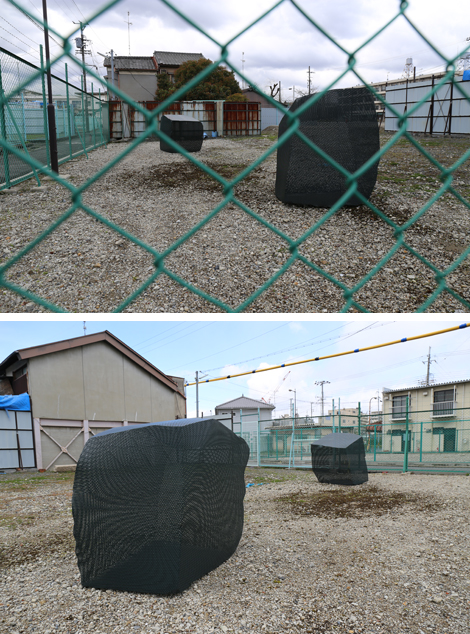
Sugiyama Masayuki, 2015
Installation view, still moving exhibition
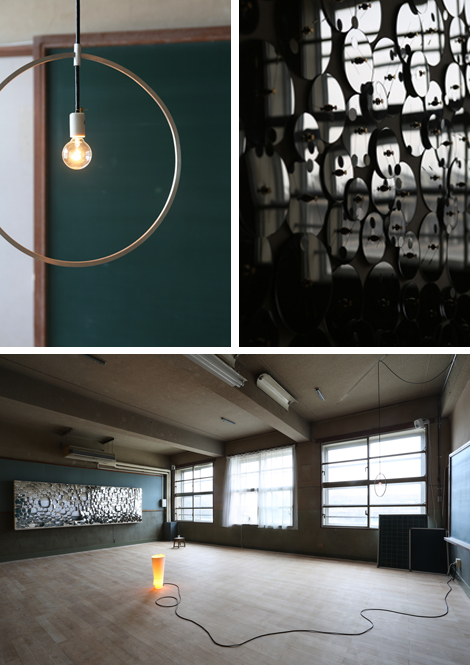
Hisakado Tsuyoshi, Quantize #3, 2015
Installation view, still moving exhibition / Photos by Kida Takeru
Actually, when on November 14 last year Yomota Inuhiko, Watanabe Naomi and I ran a public lecture (to feature in issue 19 of the journal Butai Geijutsu [Performing Arts]) with the artists at the Kyoto University of Art and Design, in relation to the plan to stage Nichirin no tsubasa using Yanagi Miwa’s stage trailer, Yomota Inuhiko raised the topic of the current situation in the Suujin district, which he had just revisited, presenting the students – as is his manner – with a provocative challenge. “It’s all very well to talk about the ‘alleyways’ in Nakagami Kenji’s writing (this being the term the writer used for the buraku community in Shingu where he was born and raised),” he said, “but do you lot know anything of the site of the buraku community in your own backyard?” In a similar vein, if I may add, seeing Yanagi Miwa’s stage trailer in front of the Kyoto Municipal Museum of Art then going to visit Suujin may be one meaningful way to experience PARASOPHIA. But I suppose that would be sidestepping PARASOPHIA, wouldn’t it? To recap my earlier comment, for those attempting to think seriously about contemporary art, but without much opportunity to see any, I would certainly recommend going to the Kyoto Municipal Museum of Art, and around the different venues, and viewing all the works. If you don’t fall into this category I’ll be frank: don’t make any special effort to take in PARASOPHIA. Experiencing PARA-PARASOPHIA will be enough.
March 6, 2015
(English translation: Pamela Miki Associates)(Publication of the English version: March 26, 2015)
—PARASOPHIA: Kyoto International Festival of Contemporary Culture 2015 | REALKYOTO | (Index of related articles)
Review : Asada Akira: PARA-PARASOPHIA: On the sidelines at the Kyoto International Festival of Contemporary Culture
Fukunaga Shin: For the First Kyoto International Festival of Contemporary Culture
Takahashi Satoru: PARASOPHIA – Institutional Engagement
—
Official Site : PARASOPHIA: Kyoto International Festival of Contemporary Culture 2015